
|
Sale 48
Pre-Long Beach Coin Auction
| The Ohringer Collection PT II - $10 Gold - Gold Bar |
| |
| |
| Lot |
Photo |
Description |
Realized |
Lot 1268 |
 |
1795 $10 Capped Bust. 13 leaves. NGC graded MS-64. In NGC holder 1776966-022. A fantastic, intensely Brilliant Uncirculated example exhibiting a needle-sharp strike on a remarkably clean planchet.
This astonishing (and quite beautiful) early eagle traces to the Freedom Collection sold by the firm of Heritage Auction Galleries. In that sale, a foundation of sorts was laid for the coin's historic significance (from which we quote): "The ten dollar gold pieces, given the name 'eagle,' were the largest gold coins produced by the first U.S. Mint from 1795 through 1804. Like all early gold coins, these pieces did not carry an actual denomination as part of the design. John Dannreuther explains: 'The eagle was the second gold denomination struck by the United States Mint. Calling it a denomination is actually a misnomer. Even though a gold eagle was denominated as a ten-dollar coin, our forefathers traded gold by the tale. [Tale, in this instance, means count or tally, a number of things taken together (i.e., the weight and purity of an individual coin).] The weight and purity were the only things important to merchants and individuals -- money was gold, and gold was money. In most cases, transactions of even a nominal sum had to be settled in gold, especially whenever governments were involved. There really was no need at first for a stated denomination on either gold or silver coins, because it was known that our coins would be under extreme scrutiny and would likely be assayed by foreign mints and others as to their weight and purity.'
"In his new reference, Early U.S. Gold Coin Varieties, Dannreuther provides estimated mintages for every variety, as well as estimates of the number of survivors for each variety. The only thing we know for sure is the number of die marriages known from 1795 through 1804 (32) and the total mintage for that period (132,714 coins including 122 pieces reserved for assay). By using the midpoint of Dannreuther's survival estimates, we can also establish an approximate survival rate for the series of 2.5%."
What a low survival ratio! It is no wonder coins like this are the crème de la crème of numismatics in 21st Century America. BD-1 is considered to be the first variety struck in 1795. "Quite a few examples survive in Mint State grades," explains the Freedom Collection description, "giving collectors a reasonable chance of obtaining a high-quality example of the Small Eagle reverse design. Many of the Mint State pieces have Prooflike fields, much like this coin does. Although the fields are not deeply mirrored, they are clearly reflective. The surfaces are exceptional and almost totally mark-free with only a few scattered abrasions. Faint adjustment marks are evident at the center of the obverse, and also on some of the obverse dentils. All of the design elements on both sides are sharply struck, suggesting to some the possibility that this may have been some type of presentation piece. This example is a relatively early die state of the variety, with faint obverse die cracks but no evidence of any reverse cracks. Despite the existence of several Mint State pieces, this example is one of the best…" and indeed it is, an incredible coin, and a first-class opportunity for the earnest buyer of rare United States gold coinage! Pop 1; 2 finer by a point. (PCGS # 8551) .
Estimated Value $400,000 - 450,000.
View details and enlarged photos
Check results on similar lots
| Unsold |
Lot 1269 |
 |
1795 $10 Capped Bust. NGC graded MS-61. Mostly well struck in natural greenish-yellow gold. Free from adjustment marks and just a few die chips noted in the planchet. A lustrous example of our first gold coin. The date on this BD-1 variety is the most closely spaced of the year and the top of the 1 is very close to the curl while the top of the 5 overlaps the bust. Star 11 very near Y with two lumps at top left of Y (these are key identifiers of the variety).
Only a few examples remain in Mint State grades, barely enough to supply the growing cohort of numismatists of means who will have to settle for a bidding tussle to finally obtain one. A fair number of the Mint quality survivors have traces of prooflike fields, much as this coin does. We cannot fail to see this coin becoming anything other than the highlight of a major early gold Type collection. Because 1795 is the initial release of the denomination, the importance of this handsome Mint State 61 example will be established for decades to come. Pop 19; 37 finer.
Estimated Value $100,000 - 110,000.
View details and enlarged photos
| Realized
$103,500 |
Lot 1270 |
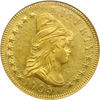 |
1795 $10 Capped Bust. 9 leaves. NGC graded MS-61. In NGC holder 2030720-014. The rarest eagle die marriage. An estimate of fewer than 500 made with 20-22 known in all grades. A far better than average struck specimen with the diagnostic die buckling in the field below the palm branch and in the upper half of the first T in STATES and at first A of AMERICA. The surfaces are lustrous with the normal allotment of light handling marks, none of which are worthy of description.
A sterling Brilliant Uncirculated example of the greatest rarity contained in the short-lived Small Eagle series of $10 gold coins, 1795-97. Within this small body of early gold varieties, a 1795 9 Leaves is just about as rare an issue as there is in the entire 138-year history of the denomination.
The 1795 9 Leaves $10 as a variety become all the more popular in recent decades upon the release of pamphlets and researcher work describing them. It was apparently known as early as 1926 when Waldo Newcomer paid $100 for a circulated example, several times the price for a commoner 1795 13 Leaves $10. Since the 1960s, examples have been auctioned an average of once every two to three years.
Designed by Robert Scot, 116 pieces were struck on March 30, 1796, according to Breen, plus an unknown (but presumably small) number struck on March 1, 1796 on Warrant No. 58, which had a total mintage of 1,169 pieces, not all of them from this pair of dies.
A small mark is located in the field by the 9 of the date; several light scuffs in the surface at Liberty's throat, with some faint signs of adjustment in the shallow-struck central hair region above and behind the ear. Such minor ephemera are apparently common to most, if not all 9 Leaves coins, and their presence indicates nothing more than little pointers when differentiating one coin from another. It may be that the dies were inspected often and quickly condemned when flaws were found since the 1795 9 Leaf reverse developed some breaks including a lump break at the tip of the second leave and another from the edge looping through the top of the first T in STATES (both present here). According to some, gold coins were important public relations items for the United States, ambassadors to the world, as it were. Because of this, care was taken to avoid releasing gold coins with die breaks or other blunders into circulation. The fields are semi-reflective, as often seen on 1795 Eagles. Today, it is believed that there are approximately 20 examples known, making it the rarest of the seven known Small Eagle varieties this year.
According to Dannreuther, "It is not known whether the 9 leaves on the branch indicate an experiment or a die cutting error, but the fact that the reverse was changed to 11 leaves for 1796 and 1797 indicates that it was an intentional experiment. Perhaps the arrangement of 13 leaves was considered too crowded and grouping of 9 leaves was thought too sparse, leading to the introduction of 11 leaves on the branch in 1796." We shall never know for sure. Pop 1; 1 finer at MS-63 (PCGS # 8552) .
Estimated Value $200,000 - 220,000.
View details and enlarged photos
Check results on similar lots
| Realized
$224,250 |
Lot 1271 |
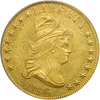 |
1796 $10 Capped Bust. PCGS graded MS-62. Well struck on a somewhat porous planchet. Free from adjustment marks with excellent detail throughout. Struck in natural greenish color gold and lightly toned with traces of prooflike surface about the peripheries. Only 4,146 minted and many times rarer than the 1795 issue.
Just one die variety is known for the 1796 Capped Bust eagle. The obverse stars total 16, reflecting Tennessee's admittance as a new state, arranged 8 + 8. LIBERTY is positioned higher on the obverse than on the 1795 varieties, starting from the peak of Liberty's cap (farther left than on the 1795 coin) and ending adjacent her forelocks. The palm branch on the reverse now bears 11 leaves instead of 13 or nine as in 1795.
The coin exhibits even yellow gold with halos of deeper gold toning around legends and devices on this famed ex Byron Reed specimen. Somewhat reflective in the fields and retaining much of its original luster, though the fields on both sides show a smattering of tiny natural planchet chips, as struck and not affecting the grade. Very few marks, hairlines, or post-striking flaws are noted, indeed, none of the usual "bones buried in the garden" with this one, which is a major plus for potential bidders -- in large part this was a byproduct of the obviously safe storage this piece received in Omaha from the time of Byron Reed's death in 1891, shortly after his active participation in the 1890 Parmelee sale. We can only imagine Reed's feeling of self-satisfaction knowing this 1796 eagle graced his collection.
Most important when considering this coin, it is exceptionally well struck, as sharp as any 1796 eagle we have seen, with more than usual detail at the extreme central obverse and especially bold detail on the eagle. A harbinger of this is the fact the eagle shows the feathers on its neck. Now that is rare. Which makes this coin all the more special. The breast is nearly fully struck, again as nice as any we've seen. The Taraszka reference mentions this Reed coin in its listing of significant specimens, where it is cited as number 2. An important opportunity to acquire a fully provenanced and very bold specimen of a significant rarity, one of only 4,146 struck and, again, representing the only die variety of this date. Pop 3; 2 in MS-63 (PCGS # 8554) .
Estimated Value $170,000 - 190,000.
From Spink America's sale of the Byron Reed Collection, October 1996, Lot 151.
View details and enlarged photos
Check results on similar lots
| Unsold |
Lot 1272 |
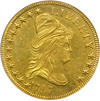 |
1797 $10 Capped Bust. Small eagle. NGC graded MS-63. In NGC holder 1562003-001. Mostly well struck on a remarkably clean planchet and shimmering with luster. Medium golden-yellow with some faint hairlines seen only under magnification. Only 55-65 known in all grades. With the exception of the 1795 9 leaf, this is the rarest small eagle $10.00 and is a candidate for finest known.
The early Small Eagle $10 gold pieces are some of the most prized acquisitions in all of numismatics. The Small Eagle type is narrowly confined to just three dates but within that range are several intriguing die varieties, and there really is only one date that can be considered available, the 1795.
The Small Eagle ten dollar pieces were struck in 1795, 1796, and 1797, but the mintage was probably produced only from September 1795 until June 1797. The 16 stars on the obverse of the 1797 eagle are arranged 12 and four. LIBERTY is positioned from just to the right of the peak of Liberty's cap to adjacent to the bridge of her nose. The mintage was 3,615, making this date the scarcest of the three Small Eagle years. A single die variety has the obverse with a fine a die break crossing from the rim through the final 7 in the date and upwards into the bust on all known examples. Another die break extends into the field from the rim below the last star on the right.
The present example boasts beautiful rich luster whose vibrancy is barely diminished by the faint hairlines already noted. Beautiful and rare. Pop 1, finest graded at either service (PCGS # 8555) .
Estimated Value $400,000 - 450,000.
View details and enlarged photos
Check results on similar lots
| Unsold |
Lot 1273 |
 |
1797 $10 Capped Bust. Large eagle. NGC graded MS-61. In NGC holder 1785326-012. Long tapered neck on the eagle. Mostly well struck and loaded with flashy mint luster, particularly so on the reverse. Free from adjustment marks and other defects, just some light handling marks in the exposed fields. A very attractive specimen, all things considered, and noteworthy in many respects for its high condition.
When the small eagle design was revised in 1797, it bore the same obverse as before, but a new reverse, generally known as the heraldic eagle or large eagle.
The eagle gazes to the left on the new design and holds in its beak a ribbon inscribed E PLURIBUS UNUM, a Latin phrase connoting One Among Many. A shield is mounted on the eagle's breast. The eagle holds a bundle of arrows in its right talons (the viewer's left) and an olive branch in its left talons, and is similar to that found on the Great Seal of the United States.
UNITED STATES OF AMERICA encircles the design, as on the small eagle 1797. A semicircle of clouds stretches from wing to wing, with 13 stars positioned between the clouds and the eagle in arrangements that vary from die to die.
Mint engraver Robert Scot's new reverse was introduced on the eagle in mid-1797, so eagles of this year are found with both reverse design types. The estimated mintage of the 1797 capped bust, heraldic eagle $10 is 10,940. Pop 32; 13 in 62, 3 in 63, 1 in 64 (PCGS # 8559) .
Estimated Value $50,000 - 55,000.
View details and enlarged photos
Check results on similar lots
| Unsold |
Lot 1274 |
 |
1798/7 $10 Capped Bust. 9 stars left, 4 right. PCGS graded MS-62. In PCGS holder 10757716. Well struck with semi reflective surfaces on both sides. Some adjustment lines on the obverse. Highly lustrous. A wonderful coin.
The eagles of 1798 are rarely offered in Mint State grade at public auction, and we are very pleased to be able to offer this stunning Mint State 62 9x4 stars specimen. This lovely example shows the usual greenish-gold tint common to early tens. The obverse has a number of very shallow, horizontal adjustment marks. Because they are so shallow they could be mistaken roller marks (seen on much later issues such as Morgan silver dollars), but since they cover most of that side, and are present on both the devices as well as in the fields, they can only be adjustment marks. Needless to say, they do little to detract from the coin's gleaming overall quality because they are so trivial; nevertheless, we feel mention should be made for accuracy's sake. Slightly weak in the center of the obverse only, the reverse are well impressed everywhere, and there are no obvious or distracting marks or edge bumps that one could speak negatively about. All in all a spectacular 1798 9x4 stars Early Capped Bust Eagle. Pop 1; none finer at PCGS (PCGS # 8560) .
Historic note: Robert Scot's designs for this denomination copied those of the quarter eagle and half eagle. Liberty's fully shaped, draped and capped effigy continued from 1795-97; the heraldic eagle derived from that of the Great Seal of the United States, continued as on the other denominations with the same mistake: the warlike arrows are in the dexter or more honorable claw, outranking the olive branch for peace.
The Eagles of 1798 have only 13 reverse stars, evidently immediately following Mint Director Boudinot's decision to stop adding a new star for every new state.
The two great rarities of this period are the two varieties dated 1798/7. The two deliveries of [900] and [842], Feb. 17 and 28, 1798, are believed to comprise, respectively, Breen-6836 with stars 9 + 4, and Breen-6837 with stars 7 + 6. Coinage of eagles was interrupted thereafter until May 14, 1799. Early breakage of both obverse dies may have been why.
Estimated Value $220,000 - 240,000.
Breen-6836, BD-1.
View details and enlarged photos
Check results on similar lots
| Unsold |
Lot 1275 |
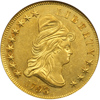 |
1798/7 $10 Capped Bust. 9 stars left, 4 right. NGC graded MS-61 PQ. In NGC holder 1785837-008. Very well struck on a completely problem-free planchet and loaded with flashy mint luster. The surfaces are golden-orange and deepen slightly within the devices. Identifiable fine lint line on the neck. A beautiful Premium Quality early eagle and thus our PQ designation.
Long considered to be very rare, enough recent appearances seem to support a population of closer to 100 rather than Breen's suggested 18-20 known (per his Encyclopedia). However, most of those known are circulated examples, unlike this lovely Mint State coin here. This particular variety is known for having a fine hairline-thin die break from the rim below the date to a point just opposite the end of the bust. Of course, with so few known in Mint State, there have only been a few auctioned over the years. Pop 5; 2 in 62, 1 in 63 (PCGS # 8560) .
Historic note: Minor change came with the eagles of 1798. The expansion of the Union was at such a pace as to threaten to overwhelm coinage designs in the future if a star was added to the design for each new state. This led the Mint director to order a standardization of stars to 13 (for the original Colonies), beginning in 1798 on the eagle.
Two arrangements of stars are found in 1798, one die with nine left and four right, and one die with seven and six. All of the 1798 eagles are actually overdates: 1798/7, with the 8 punched into the die over a 7. No perfect date 1798 capped bust eagles are known.
The total mintage of 842 1798/7 capped bust eagles makes this the rarest of the capped bust eagles by mintage. Both obverse dies broke early, likely accounting for the cessation of production after so few were made, according to Breen.
Estimated Value $100,000 - 120,000.
View details and enlarged photos
Check results on similar lots
| Realized
$138,000 |
Lot 1276 |
 |
1801 $10 Capped Bust. PCGS graded MS-64. Consistered the most common early eagle thus ideal for a type set. A gorgeous well struck example on a problem-free planchet and loaded with frosty mint luster thoughout.This beauty sparkles with original mint bloom colors of sunset gold. We have seen many 1801 eagles and a curiosity of this obverse die is that it often shows a number of short "spines" in the cap of Liberty -- which are die clash marks from the vertical lines from the shield. The striking quality on this piece is rather striking in its sharpness, if readers will overlook the pun, and shows amazing detaill. This is rare for any early ten insofar as there is complete definition on Liberty's hair waves, the cap, and also on the eagle's breast feathers just above the shield on the reverse (a spot where weakness occurs more often than collectors would like to admit). The mint luster is rich with satiny frost. There is a nice overlay of patina on each side, as described above. Very smooth surfaces are noted, the most obvious evidence of this coin's careful preservation. Sure to be of great interest to collectors who buy early Capped Bust gold, this issue is almost unavailable any finer. Pop 34; 3 in 65 (PCGS # 8564) .
Estimated Value $110,000 - 120,000.
View details and enlarged photos
Check results on similar lots
| Unsold |
Lot 1277 |
 |
1803 $10 Capped Bust. Extra star. PCGS graded MS-63. In PCGS holder 50190972. Very small 14th star punched within last cloud. Well struck with some light adjustment marks faintly seen on the obverse. Loaded with frosty mint luster while exhibiting full rich mint bloom colors of light olive, golden-orange and light rose highlights. Offered here is without question a wondrously preserved early Large Eagle ten dollar, featuring as it does bright surfaces free from spotting, and devices that are carefully preserved through the centers. This does show occasional softness on lower part of Liberty's bust, but that is all. An interesting long die break through the right wing is noted as well. There are no large or reportable marks on either side of this desirable early Capped Bust ten dollar.
The Philadelphia Mint struck an estimated 15,017 1803 capped bust eagles from a single obverse die and several different reverse dies. The reverses are known with Small Stars and Large Stars. This, the strangest variety for the Large Stars 1803, has faint traces of a fourteenth star punched into a cloud! Pop 2; 1 in 64 (PCGS # 88565) .
Estimated Value $65,000 - 75,000.
View details and enlarged photos
Check results on similar lots
| Realized
$77,625 |
Lot 1278 |
 |
1804 $10 Capped Bust. NGC graded MS-63. In NGC holder 1910099-002. A far better than average strike for this issue and shimmers with intense mint luster. Some light die buckling in the field as always behind the hair. Wonderful original surfaces, slightly greenish-golden in color. The luster is very attractive with a shimmering, satin texture to the richly colored surfaces. Struck on a decent planchet with some faint adjustment marks noted on the reverse. Rare low mintage date as only 3757 were made, many of which were later melted when the weight and composition was lowered in 1838.
As the last eagle struck in the early Capped Bust series before a long hiatus ensued, the 1804 is an historically significant issue. Breen believed that only six Mint State pieces existed as of 1988 when his encyclopedia was published, while Akers found only 14 offerings of Mint State coins in five decades, many of them presumably reofferings. Fewer than 100 exist in all grades, undoubtedly including, again, some duplication.
The reverse for 1804 BD-1 was used for striking 1803, BD-6 of the previous year. Dannreuther suggests "the mintage totals for this year, already a scant 3,757, undoubtedly include some coins dated 1803!" He goes on to note that "most of the known example of this date/variety have blunt strikes." Pop 5; 1 finer by a point.
Estimated Value $150,000 - 175,000.
View details and enlarged photos
| Realized
$161,000 |
Lot 1279 |
 |
1878 $10 Liberty. NGC graded Proof 65 Cameo. In NGC holder 1930947-017. A stunning gem proof example of this coveted date. The mirror fields are watery in appearance and the frosty devices appear to jump right off the coin! A marvelous untoned specimen and the finest graded at either service. Here is a candidate for finest known.
Only 20 proof tens were struck of the 1878 ten dollar, and a reasonable estimate is that around 7-10 pieces are available today as unimpaired Proofs. Very few have been certified by both of the major services combined, with this the finest specimen by far! This is a well-balanced piece that has gleaming fields, which accounts for the PR65 grade. The fields are very deeply mirrored, in fact, while the devices show gorgeous mint frost that gives the coin its two-toned, cameo designation that is so important in determining a Proof gold coin's ranking in the hierarchy of grade levels. Light, even, reddish-gold surfaces with no distracting contact marks or planchet flaws. We note a tiny spot by the right-hand "stop" which separates DOL. from AMERICA on the reverse. This can be an indicator (along with the NGC serial number) for tracing the coin's provenance in decades to come. We aren't even going to try to trace the pedigree of this incredible coin, as it has likely been off the market for years and years. Pop 1; none finer (PCGS # 88818) .
Estimated Value $55,000 - 65,000.
View details and enlarged photos
Check results on similar lots
| Realized
$89,125 |
Lot 1280 |
 |
1892 $10 Liberty. PCGS graded Proof 64 Cameo. A brilliant untoned example with excellent cameo contrast. Only 72 Proofs minted. One might assume the fairly high Proof production of 72 pieces would imply relative availability; however, there are very few high grade 1892 Proof examples that appear in the numismatic marketplace. And unlike dates in the latter half of the 1890s, only a handful of the Proofs of this year show cameo contrast, making the Cameo designation of the present example a bonus. Beautiful bright color, spot-free and with handsome arm's-length eye appeal, plus a bold strike and an absence of marks complete the package. A light toning streak in the lower reverse may have kept this beauty from a higher grade. Pop 2; 1 finer by a single point (PCGS # 88832) .
Estimated Value $25,000 - 28,000.
View details and enlarged photos
Check results on similar lots
| Unsold |
Lot 1281 |
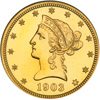 |
1903 $10 Liberty. NGC graded Proof 67. In NGC holder 1785864-010. A nice brilliant example. Boldly struck. Only 96 Proofs minted. The 1903 is very scarce when judged in the context of post-1900 Proof eagles. It is more difficult than the 1900, 1902, and 1904 and is almost always found in the "all brilliant" form. Akers estimates that no more than 25-30 specimens exist today, while Breen has a more liberal count of 35-40 Proofs. We tend to go with Akers' numbers since this is one of the few we have handled in a number of years.
The coin is a textbook lesson in how to tell an "all-brilliant, no-contrast" coin from the Proofing method developed in the Mint after 1900. There is little or no contrast between the fields and devices. The raised portions of the design exhibit as much die polish and brilliance as do the recesses. For pedigree purposes, a microscopic flyspeck the size of an amoeba is noted on the reverse between E and S of states. Look quickly and you'll miss it. This is tied with the finest example certified by NGC, and in fact, could be one and the same coin. Pop 2; none finer at NGC (PCGS # 8843) .
Estimated Value $65,000 - 70,000.
View details and enlarged photos
Check results on similar lots
| Realized
$74,750 |
Lot 1282 |
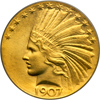 |
1907 $10 Indian. Wire rim, periods. PCGS graded MS-66. An exquisite specimen featuring immaculate satiny smooth surfaces throughout. Simply a superb sun bright golden gem that should draw considerable bidder interest. Only 500 minted.
As we have commented upon elsewhere, 1907 was a watershed year in American numismatics. Tossed out were several mediocre coin designs that had outlived their usefulness. Teddy Roosevelt, spearheading the revolution, forced the Mint to bring its coinage design up to twentieth century standards. This was an era when politicians and statesmen were flexing the government's muscles, so to speak. America's brand-new navy, christened the Great White Fleet was steaming around the world on its grand tour as sort of a chest-pounding exercise. What we were telling the other great powers was that America, too, was a power to be reckoned with; America, too, could throw its iron muscle around; America, too, had the wherewithal to defend its beliefs. Regardless of one's opinion of nationalism, whether it be all mighty or all foolhardy, Theodore Roosevelt was in the vanguard of this American "awakening." These elegant Ten Dollar Pieces by Augustus Saint-Gaudens were one of the more visible aspects of this modernization program, and should be cherished as others cherish artifacts from prior, historic openings.
It is difficult to turn your gaze away from the lovely color of this coin after communing with its satin to matte-like surfaces. The fields show a myriad of light raised die polishing marks, indicative of the preparation of the dies in anticipation of actual coinage. Some might almost mistake this as a Satin Proof, since the die polishing lines are quite similar to those seen on Proof 1907 High Relief Double Eagles and the Satin Proof 1907 "Rolled Edge" $10. However, we'll leave it to our bidding audience to decide how to value this impeccable MS66 example of one of the more famous U.S. gold pieces.
What a marvel it is to hold, catalog, study intently, and photograph. We can only imagine the thrill that the new owner will get from the mere pleasure of possessing this jewel. Pop 15; 3 in 67 (PCGS # 8850) .
Estimated Value $70,000 - 80,000.
View details and enlarged photos
Check results on similar lots
| Realized
$97,750 |
Lot 1283 |
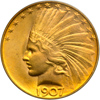 |
1907 $10 Indian. Rounded rim, periods. PCGS graded MS-65 PQ. A stunning gem specimen with virtually immaculate satiny smooth surfaces throughout. The rich golden sunset mint bloom colors further adds to its beauty. Definately a Premium Quality coin that deserves an even higher grade. Net mintage 42 pieces.
The great rarity of the 1907 Rolled Edge With Periods $10 gold pieces can be ascribed to a decision made by Director of the Mint Frank Leach. In a letter from Superintendent of the Mint John H. Landis to Leach dated September 25, 1907, Landis says that examples of both this design and the adopted 1907 No Periods design were supplied to Leach and that the No Periods design was more suitable for a circulating coin. The problem with the Rolled Edge With Periods design was felt to be a lack of fine detail and sharpness. The pronounced rolled edge also gave it poorer stacking abilities than the broader edge of the No Periods design. In this same letter, Landis noted that "we have on hand $315,000 of the first model (this 1907 Rolled Edge With Periods design), struck on the coining press, and $500, struck on the medal press." This would seem to imply a total of 31,550 pieces. It is uncertain whether more were made; however, it is believed that nearly all were melted per the wishes of Leach, save for 42 pieces, and mass production of the No Periods design began shortly thereafter.
This is an utterly breathtaking, bold Gem Mint State specimen. The surfaces are smooth as silk in their sheen. Furthermore, we can find nary a distracting spot or serious abrasion on either side. Fully lustrous with a frosted texture to the finish, all areas appear as sharply defined as possible for the issue. As stated, lovely, thick mint frost covers each side while magnification reveals a few small swirling die polishing marks, like the Wire Rim tens only to a lesser degree. The warm colors are immensely pleasing. A tiny, well concealed obverse nick at the top of the feather that ends in T of LIBERTY should help maintain the provenance of this important 20th gold rarity. Above the L of PLURIBUS is a small surface void, possibly a flake of metal (as made). The 1907 Rolled Edge coin has pretty much vanished from auction offerings in recent times, and it may be years before it surfaces again, if indeed it ever does. Pop 16; 14 in 66, 3 in 67 (PCGS # 8851) .
Estimated Value $225,000 - 250,000.
View details and enlarged photos
Check results on similar lots
| Realized
$230,000 |
Lot 1284 |
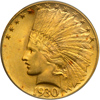 |
1930-S $10 Indian. PCGS graded MS-65. A well struck gem with gorgeous original surfaces throughout as evidenced by the natural russet toning spots on both sides.
A widely sought, rarely available key to the Indian $10 eagle series, the 1930-S is the only gold delivery of the 1927-1931 years insofar as the ten-dollar denomination is concerned. To some, it may surprise that most have survived in Mint State grade. Rarer than even a limited original mintage of 96,000 coins might imply, and the issue is believed to have seen widespread melting in the Mint. Only a few got into collectors' hands. For this reason, the '30-S is not rightly thought of as a condition rarity. However this doesn't mean the issue isn't an absolute rarity with precious few coins in existence at all grade levels.
Catalogers take tremendous pride when given the opportunity to describe a 1930-S Indian Eagle in Gem condition. The fact that this coin is a smooth-looking, blast-of-gold honor-roll specimen makes it all the more enjoyable to examine and describe. Both sides gleam with dominant reddish-gold color that yields to lighter rose-colored tinting in a few isolated areas on the obverse such as within the feathers. Pleasingly sharp striking detail is seen inside and out, as is flowing mint frost that defines the word "exceptional quality" (even by the standards of this well-produced issue). There are scarcely any abrasions to be found. The eye appeal alone places it close to an even finer Gem rating. In closing, a coin that will easily serve as a centerpiece in an advanced collection of 20th century gold. Pop 15; 3 in 66, 1 in 67 (PCGS # 8883) .
So what would $10 buy you in 1930? Using prices from Morris County, New Jersey (of all places), "a survey of retail prices advertised in the Daily Record, October 1-15, 1930" we find that Women's shoes, leather heels, cost $10.00 a pair; a Housekeeper, $30.00 a month; a Hungarian cook, 12 years experience, $75.00 a month.
Bread, Victor's (big pan loaf) 5¢ (that's a lot of loaves for $10!); Eggs, 39¢ a dozen; Beef, prime rib, 29¢ a pound; Toilet paper, American 20¢ for 3 rolls; Morristown, 5 room house for sale, $3,500 (meaning 350 of these lovely gold coins); Mt. Tabor 5 room house for rent, $20.00 a month; Kittens, angora, $5.00 each (two for a 1930-S $10, a bargain), Typewriter, Underwood Standard, "like new," $37.50.
Estimated Value $60,000 - 65,000.
View details and enlarged photos
Check results on similar lots
| Realized
$60,375 |
Lot 1285 |
 |
1933 $10 Indian. NGC graded MS-65. In NGC holder 1825778-002. Well struck and fully lustrous, light golden-orange mint luster. Some stray marks on the cheek and chin are the only imperfections worthy of note. The fields are remarkably clean on both sides. The only collectible coin of this date and the key coin in the series.
Unlike the pre-1920 Indian tens which have a satiny finish, the 1933-dated coins (of which almost all known examples are Mint State) display decidedly frosted mint luster. This piece has, in addition to a golden-orange hue, shades of natural reddish-gold color from the 10% copper alloy used to improve wearability of America's .900 Fine gold coins. The surfaces are very clean even for a Gem, with only a slight contact from stacking at Liberty's face below the area of the ear. The design details are strong throughout, as expected, the 1933 issue being one of the best made $10 gold pieces in the series. A memorable and most spectacular coin for the rarities connoisseur. Pop 4; 1 in 66. (PCGS # 8885) .
In 1933, Franklin Roosevelt assumed leadership of a nation in despair. Banks were closing across the country. Among the country's myriad problems, commodity price deflation had driven many Americans to the point of bankruptcy. One strategy Roosevelt adopted in an attempt to address the commodity price problem was a year-long manipulation of gold. He would attempt to induce inflation, thus raising prices, particularly commodity prices. Roosevelt's strategy moved through three phases.
Immediately upon assuming office, Roosevelt instructed the U.S. Treasury to cease honoring requests from Americans to exchange their paper dollars for gold. This was the first step in removing America from the gold standard. Dollars would, he hoped, remain in circulation and be available for commodity purchases. With prices continuing to drop, however, the President convinced Congress to make unenforceable all contract clauses calling for payment in gold, a common payment requirement in both government and private contracts of the time. This would reduce pressures upon the Treasury to release more gold into the economy. Prices continued to fall. In a final attempt to mitigate the country's economic depression through gold manipulation, Roosevelt and his advisors tried to circumvent market forces by personally manipulating the price that the U.S. Government would pay to buy gold still in circulation. By driving up gold's value, the Administration hoped to pull the metal from the marketplace, to be replaced by paper currency. By January 1934, Roosevelt had revalued the gold price to $35 an ounce from the $20.67 it had been before. (From "Gold Follies of 1933.")
Now, on to the coins: Following its huge mintage of 4,463,000 pieces in 1932, attesting to the panic hoarding then going on, the Philadelphia Mint opened 1933 with a decent supply of 312,500 eagles in January and February. A few of these coins, perhaps 30-40 pieces, were legally released through ordinary channels at this time. The aforesaid presidential order concerning gold withdrawals not only arrested gold coin production, but drove the Philadelphia Mint to melt all residual 1933 eagles. Fewer than 30 came to light in an east coast hoard circa 1952, according to sources. Although a few more individual specimens have since turned up in French and Swiss banks, the 1933 still holds top marks as the rarest Indian eagle in all grades.
Estimated Value $450,000 - 500,000.
View details and enlarged photos
Check results on similar lots
| Realized
$450,000 |
Lot 1286 |
 |
1861-S $20 Liberty. Pacquet reverse. PCGS graded AU-58. Well struck with intensely lustrous light yellow golden surfaces. Normal allotment of light chatter marks in the unprotected fields. A splendid extremely high grade example and certainly one of the finest known.
The fields retain extensive luster (not often seen), while the strike is complete and balanced including full obverse stars. Free of annoying rim bruises, too, or other value-impairing circulation-related problems, this coin will persuade the experienced numismatist who appreciates such quality to place a bid. Identifiable by a small impurity spot in the metal below the right wing of the eagle.
The internal squabbles within the Philadelphia Mint that the public knew nothing about persisted unabated when 1861 rolled around. Mint Director Snowden and others seemed to disapprove of Chief Engraver James Longacre. Some say they actively worked to undermine his authority. One such attempt was this new reverse die engraved by Anthony C. Paquet. The reverse letters on the Paquet design were taller and more narrow than on the Longacre design, and was briefly accepted, but when a few double eagles were coined from it, the mint staff realized that there was insufficient room for the border, thus the design elements would wear quickly, and the Philadelphia Mint stopped production. Mint Director Snowden cabled the San Francisco Mint and asked them to use the old leftover dies rather than the new Paquet reverse, but 19,250 had already been coined. Rather than melt perfectly good coins, these S-mint Paquet reverse double eagles were released into circulation, along with the regular dies coins in 1861.
In 1937 A. J. Fecht first noticed the unusual reverse die, and called it a pattern in "The Numismatist" for March 1937, page 199. It wasn't until 1951 that the archival record revealed the story behind this reverse die made by Paquet. Most of the surviving 1861-S Paquet $20 gold pieces came from Europe and are heavily bagmarked.
The Paquet pieces are generally referred to as having "taller letters," than the coins struck from Longacre-produced dies. There were more changes than this made by Paquet, with the letter size being relatively minor. The scrolls and eagle are larger, and placed closer to the denomination; the eagle's head has been remodeled, while the ring of stars is widened with the rays removed from within it. In the process of enlarging the shield, Paquet seems to have made an error: he put 17 horizontal lines, thus creating a 16-stripe shield instead of the official United States 13-strike one. PCGS reports only 2 at this level and none finer. (PCGS # 8936) .
Estimated Value $120,000 - 140,000.
View details and enlarged photos
Check results on similar lots
| Realized
$166,750 |
Lot 1287 |
 |
1863 $20 Liberty. NGC graded Proof 65 Cameo. Housed in NGC holder 1785851-015. An outstanding Gem Proof example exhibiting superb sunset golden color throughout. The bright mirror fields are virtually free from hairlines and the froslted devices are flawless! Only 30 proofs struck for this "no motto" double eagle.
A visually spectacular and thoroughly enticing example of this prized No Motto rarity in the double eagle series. A bright specimen with frosted motifs -- and kept that way, intact and unharmed through wars and tribulation for the better part of a century and a half. What deeply mirrored fields! The fields form a smooth-as-ice platform for the sharp cameo contrast. Though the reported Proof mintage for the year is a meager 30 pieces, it may be that only 10 or so examples can actually be traced with any certainty today. Of those, two are in museum collections, with another two or three being impaired. If the Mint sale in 1863 amounted to 15 or 20 of the 30 Proofs made, this would account for the paucity of offerings. In those days, Proof gold coins bought at the Mint had to be paid for in gold coin (specie), typically available only from a bullion dealer at a stiff premium in terms "greenback" paper currency. For example, one report has it that the "premium" in 1864 (the year after this coin was minted) went to 240% on the New York gold exchange. To buy $100 in gold coin, one had to tender $240 in greenbacks. That would mean the "price" of a Proof $20 (not counting the Proof-minting fee) was more than double face value -- a stiff premium in those days. Neither the Norweb nor Browning collections, which were both notable for their fine runs of Liberty $20 Proofs, contained an 1863 Proof. The present beautiful Cameo Gem Proof double eagle is one of a threesome graded by NGC at this time. This truly is an opportunity for an advanced double eagle buyer! Pop 3, none finer at NGC. PCGS reports 2 in PR-64 Cameo. This gem is certainly a candidate for finest known (PCGS # 89075) .
Estimated Value $200,000 - 225,000.
View details and enlarged photos
Check results on similar lots
| Realized
$241,500 |
Lot 1288 |
 |
1864 $20 Liberty. PCGS graded Proof 64 Cameo. An absolutely awesome coin! This spectacular treasure glitteres with rich sunset golden color throughout. Only 50 Proofs minted and this stunning double eagle may well rank as the finest. An extremely attractive, seldom offered Liberty Type 1 double eagle Proof, no question about it, and one whose importance to collectors has long been a feature of the numismatic scene. Very few dates among No Motto $20 gold pieces are offered in Proof. The few that are all have minuscule production figures. Furthermore, it is believed (and is a near-certainty) that many Philadelphia Mint twenties from the Proof 1864 mintage were melted. The actual number in collector's hands remain untabulated for the obvious reasons.
This glittering beauty offers dramatic visual impact from its vibrant rich color. The mirror reflection over both sides appears close to gem caliber with little fear of contradiction. Both sides display bold frosted relief that shows strong contrast against the mirror background. While just about any Proof struck in the 1860s can be described as a top-star rarity, the first 10 No Motto dates in Proof are particularly popular. You would hardly credit the agony it gives a collector of Proof twenties by date to sit idly by while another acquires the seldom seen 1864 issue! PCGS reports a total of 5 with none finer. (PCGS # 89076) .
Estimated Value $140,000 - 150,000.
View details and enlarged photos
Check results on similar lots
| Realized
$161,000 |
Lot 1289 |
 |
1868 $20 Liberty. PCGS graded Proof 64 Cameo. A blazing untoned brilliant Proof example with excellent cameo contrast. Of the 25 coins struck, most specialists agree that as few as a dozen remain. This coin, because of its strong cameo frost, displays the gold-on-black contrast these are famous for (coins in choice condition, anyway). Clearly a coin of immense beauty and perfect proportions, strongly supported by a wide, sharp rim that gives the central composition a nicely framed appearance. Not many Type 2 twenties have received the "Cameo" designation.
To reiterate, this is an beautiful Proof coin, remarkable for an early date (Type 2 $20 gold pieces were minted in small numbers for limited number of numismatists in America in the post-Civil War era). What's more, the coin it is even more electrifying inasmuch as it is preserved far better than just about any other from 1868. Examination reveals only a few tiny imperfections, primarily a group of barely-visible flakes in the lower obverse field near Liberty's bust point. They are more like tiny toning spots than anything else until a strong magnifier is used to enlarge the area. The color, vivid orange-gold with gleaming radiance, with strong cameo contrast present on both sides. There is little argument this example may bring a high bid when sold, if not a record price, then certainly within the range of one. Pop 2, none finer. PCGS reports only 2 with the Cameo designation, possibly the same coin (PCGS # 89083) .
Estimated Value $90,000 - 110,000.
View details and enlarged photos
Check results on similar lots
| Realized
$106,375 |
Lot 1290 |
 |
1869 $20 Liberty. PCGS graded Proof 64 Deep Cameo. An absolutely exquisite brilliant Proof with superb deep frosted cameo surfaces. Only 25 were minted.
Close upon the heels of the 1868 Proof comes this exquisite Proof 64 1869 $20 whose beauty inspires nods of appreciation within the collecting community. For the truth is, the cameo contrast is very strong, much more so than one usually finds with coins struck in the 1860s. Deep Cameo is too limiting a term to capture the true performance of this coin's rich beauty and pageantry. To say that the devices are merely "richly frosted" gets nearer the truth; what's more the finish is set against glittering, smoothly mirrored fields that go very "deep," as they say, when the coin is held at an angle in the light. The brilliant reddish gold shade along with an appreciable absence of marks or hairlines puts it near the forefront of the few Proofs remaining in collections.
Proof Double Eagle issuance at the Philadelphia Mint was the same as in 1868: only 25 were sold in 1869. Perhaps half as many remain. That being said, this is one of the most beautiful specimens of a Proof 1869 Double Eagle to come along in a long while, something we feel privileged to auction. Its sale will be watched keenly by specialists in the double eagle series. Pop 2, none finer. PCGS has graded just two Proofs with the Deep Cameo designation, possibly the same coin. (PCGS # 99084) .
The Gold Panic of 1869: A famous gold market "corner" took place on Wall Street on a Friday in the autumn of 1869. Two cunning speculators, Gould and Fisk, parleyed their "position" in gold into a near corner. They would have succeeded, too, had not President Grant instructed his Treasury Secretary to release some of the government's gold into the market to stem the buying frenzy. Prices in the metals markets, which had gone to a premium of 42% over par during the heat of the action, plummeted. And it took many months for international trade to return to normal afterwards. The Gould-Fisk manipulation would go down in the history books under the name of Black Friday.
Estimated Value $100,000 - 120,000.
View details and enlarged photos
Check results on similar lots
| Unsold |
Lot 1291 |
 |
1869-S $20 Liberty. PCGS graded MS-64 PQ. Well struck with smooth satiny mint surfaces remarkably free from chatter marks and other disturbances, thus our Premium Quality designation. Light golden-orange and pale olive mint bloom colors add to its desirability.
No doubt about it: this is a very rare Type 2 San Francisco mint issued $20 gold piece for the collector to who seriously desires the choice Mint State grade. The surfaces are simply magnificent for what is usually an insipid and bagmarked date. Most other double eagles made at San Francisco in 1869 are heavily abraded, circulated, or lost forever. They are nearly impossible to find in other than so-so states of preservation.
The coin offered is one in a million! Note Liberty's beautiful facial profile in the photograph (or, if you are among he lucky few, in the viewing area of your magnifying glass when examining it first-hand). Notice the surrounding fields, whose smooth contours show just trivial scuffs and a few minute tics, unlike the heavily scratched surfaces of others. The luster is frosty. Clear-cut devices excepting the stars point to it having been giving a decent, but not quite 100% full strike by the dies. No other weakness occurs: the hair is crisp; the eagle incredibly bold. The rays of the sun and most of the reverse stars show every detail. Back on the obverse, even the pearls lining the coronet can be seen plainly, while the reverse impresses us with its near perfection of strike and near gem quality luster. Examination of the reverse fails to find a fault, and this portion of the coin would probably grade even higher on its own, as we alluded to. The coin is identifiable by a tiny diagonal nick by the first star on the obverse. As to rarity, that is where the beauty of this 1869-S twenty really shines (see below). Obviously, the coin is a contender for the finest known of the date, and as such has quality that is highly coveted by all advanced collectors. Expect strong competition for this coin when it crosses the block. Pop 5, tied for finest graded at PCGS. Here is a candidate for finest known (PCGS # 8956) .
Estimated Value $55,000 - 65,000.
View details and enlarged photos
Check results on similar lots
| Realized
$69,000 |
Lot 1292 |
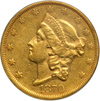 |
1870-CC $20 Liberty. PCGS graded EF-45. A lovely bold example, free from the rim bruises and other decernable marks usually associated with this first and rarest of all Carson City gold issues. Some honest wear with only minimal handling marks. The surfaces are mostly untoned with traces of mint luster in the protected areas. Only 3789 coins minted.
We are pleased and proud to offer this magnificent rarity, the 1870-CC. What is unusual about this specimen is how carefully preserved it is, as stated in our opening comments. There is little or no wear to speak of on most of the high points. Many dealers who examined it believe it may actually grade a shade higher than the conservative opinion assigned by PCGS. With rarities of the caliber of 1870-CC, the grade on the holder doesn't matter as much as the coin contained in it. There are some light handling marks, as always seen on this date and mint. Fortunately there is no "worst" mark. About the only ones we feel should be called identifiers (to use the popular weasel word) are: a shallow chattermark below the C of AMERICA on the reverse and another tiny scuff on Liberty's nose. Hardly the sort of things one gets overemotional about. The coin is definitely on the high side of attractiveness. Rather well struck for an 1870-CC too, although the stars are flat, Liberty shows full hair curls. The reverse for its part, is nicely detailed and free from problems from circulation. To repeat: plenty of luster lies protected by the devices.
This is the die pairing with the CC mintmark slightly left when compared with the other reverse die. The PCGS Population Report is given at the end of this description. We noted in an earlier sale: "As is the case with virtually all American rarities, certification data are largely useless, since valuable coins such as this 1870-CC $20 are apt to play tag or musical chairs and be submitted and resubmitted to various services, thus ballooning the number beyond any reasonable estimate of the actual quantity of different pieces extant."
A foremost rarity in its own right, far and away the rarest CC-mint $20 and the first year of issue from this Mint. The survival rate, probably less than one percent, means perhaps 35 to 50 coins are extant today. We would not be surprised to see this coin bring a new record for the date and grade. Pop 10; 4 in AU-50, 1 in AU-53. (PCGS # 8958) .
Estimated Value $250,000 - 275,000.
View details and enlarged photos
Check results on similar lots
| Realized
$345,000 |
Lot 1293 |
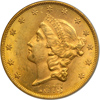 |
1873-CC $20 Liberty. PCGS graded MS-63. A marvelous well struck example exhibiting lustrous frosty mint surfaces with full mint bloom colors. Only 22,410 struck. To put it mildly, this is a boldly struck example of the rare Carson City Mint issue of 1873, a coin that exhibits lovely rose to reddish gold patina and has rolling "cartwheel" luster from edge to edge. A few blemishes are limited to three separated marks at Liberty's cheek. Also, there is some moderate abrasion on the reverse rim near 7 o'clock. In days gone by, $20 gold pieces weren't collected as numismatic items but were used simply and exclusively as bullion for payment of goods and services rendered or due. For some inexplicable reason, this gorgeous coin remained Uncirculated, pure, unsullied. How and why are best left to those who can read crystal balls, like the clumsy bobble-eyed Divinations witch in the popular Harry Potter stories!
Everybody with numismatic learning is cognizant of how difficult this date is to obtain. It turns out that 1873-CC was a very rare year for any coin denomination from Carson City. Collectors universally proclaim its importance. But what do we know of the year itself? Without some historical point of view, what is this, after all, but just another rare coin? Yet the '73-CC is a lot more than that. President Ulysses S. Grant was in his final term as President, struggling with the issues of Reconstruction in the East and South, fending off scandals in his administration, and having to come to terms with a sharp, hard Panic in the summer and fall of 1873. It was the age of rogues called Carpetbaggers. Railroad tycoons were picking the pockets of the unsuspecting taxpayers. President Grant probably already had the cancer which would end his life in 1885 -- one of the ravages of the war he had helped the Union to win. For numismatists today, of course, this important year signaled the passage of the Coinage Act of 1873, in which hard-money gold currency advocates of the time convinced Congress to demonetize silver. This, of course, was the reason Carson City would coin no silver dollars the next year (although the new Trade dollar would take its place in the coining presses, it was rarely in use in America itself but was for Asian export only). In the Western third of the country, which concerns us most here, railroads were snaking across the landscape. The year before (1872) a deadly plague attacked horses, killing or sickening millions of them (the long-forgotten Great Epizootic of 1872 as it was called back then). The invention of barbed wire was still a year off (1874) and the Indian Wars occupied the energies of William Tecumseh Sherman of the U.S. Army, a butcher to the last drop, which would soon engender blowback in the personage of a remarkable Native American commander who called himself Crazy Horse (1876). Verily, 1873 was a busy year! Place this 1873 Carson City double eagle rarity against those realities. It's a "real" coin, and not only part of a remarkable heritage -- but also a palpable image of the times themselves. To paraphrase a line from Indiana Jones: this coin isn't just passing through history, it IS history! Pop 1, finest graded at PCGS. NGC has graded one example with none higher. Here is a candidate for finest known (PCGS # 8968) .
Estimated Value $100,000 - 110,000.
View details and enlarged photos
Check results on similar lots
| Realized
$112,125 |
Lot 1294 |
 |
1882 $20 Liberty. NGC graded Proof 66 Ultra Cameo. Star. Here is the ultimate 1882 Double Eagle. Undoubtedly the Finest Known Example!. An immaculate brilliant yellow golden gem with deep ultra cameo frosted devices which are blemish- free! Only 59 struck for this rare key low mintage date. In 1882, the Philadelphia Mint struck both business strikes and Proofs, all in very limited quantities, and today, this key issue is one of the most desirable in the entire double eagle series. Total production amounted to just 571 business strikes and the aforementioned 59 Proofs. Scarcely surprising, it is thought that about dozen Proofs are all that survive. Among the Proofs are examples from famous-name collections of Newcomer, Boyd, Garrett, Eliasberg, and Trompeter, etc.
The fields on this Proof 66 are profoundly mirrored with the watery or "orange peel" appearance seen on nearly all first-class gold Proofs in the 1880s. Both sides have highly lustrous and exemplary frosted devices, free from polish areas which tended to lessen the cameo effect on lesser coins. The connoisseur will expect to hear that this example exhibits no defects whatsoever, which is, of course, the case. The coin's complete lack of imperfections means tracking it will be a piece of cake since no others come within a country mile of its near absolute perfection! The Proofs this year were struck from a single die pair. Of the 59 made, 25 were issued with the gold sets February 14, 2 more before March 31, 2 in second quarter, 15 with sets August 12, 5 more before September 30, 10 in fourth quarter, according to archival records. As a date, 1882 is rarer than the more highly proclaimed 1883 and 1884.
Today, the possession of an 1882 Proof double eagle in any state of deterioration, from either method of production, is a major turning point for the collector. Further, the possession of this incredible immaculate Proof 66 1882 beauty, which is free of deterioration, should be a highlight of the century for any tried and true numismatist! Pop 1, finest graded at NGC. PCGS has graded 1 example in PR-64 DCAM. (PCGS # 99098) .
Estimated Value $150,000 - 175,000.
View details and enlarged photos
Check results on similar lots
| Realized
$195,500 |
Lot 1295 |
 |
1887 $20 Liberty. PCGS graded Proof 65 Deep Cameo. Candidate for Finest Known!. Well struck with beautiful glittering orange-peel surfaces and deeply frosted surfaces. A brilliant deep yellow golden gem with immaculate spot-free surfaces. Only 121 coins minted for this Proof-only issue.
Among the rarest Type 3 Proofs ever released to collectors, this design was modified from the 1866-1876 double eagles by the then-aging (and soon to expire), Chief Engraver William Barber. (Barber would be replaced in the position by his son, Charles E. Barber in 1879.)
The Liberty head on the Type 3 is more upright and placed more squarely in the center of the design. Barber then adjusted the reverse by including the denomination in its entirety TWENTY DOLLARS along with many other subtle changes to the central motifs. A marvelous improvement, many would say, and splendidly displayed for all to admire in this exceptional Deep Cameo specimen graded by Professional Coin Grading Service.
The coin presently offered comes at the end of a run of extraordinary rare Proof-only or virtually Proof-only P-mint twenties struck in the decade of the 1880s. There were 121 Proof double eagles made in 1887. None struck for use in circulation. In all grades, this Proof-only date is considered a rarity. In top grades, above the usual hairlined, nicked Proof 63 quality, for instance, its fame is locked rigidly for all time. The present specimen is the only piece certified this high in Deep Cameo at PCGS. For that matter, the only PCGS-graded Gem Deep Cameo.
Offered two years ago in a sale by Heritage Auctions, it displays striking frosted contrast that is an infinite improvement over later Proofs in the series where the mint decided to switch to a more all-brilliant look. The contrast here is showy to optimal effect against the deep mirror, almost "black with depth" reflective field on both sides. Liberty's hair, of golden frosted hue, her eyes, in aspect, wide open and looking out upon a fresh new world, in color, the coin is vibrant and glowing.
All objective evidence points to it being very conservatively graded. There are two or three small identifying features, but since this is the finest certified by PCGS, and has the PCGS serial number 10165413 on the label, this may serve entirely for purposes of tracing the coin's provenance in the future. A marvel of coin preservation, definitely a "find" for any discriminating buyer to obtain, and a coin whose pleasing overall aspect is one that will draw attention from other collectors. Upon first viewing it, a collector will sigh as if owning it in his dreams could be the only hope. In other words, unimpeachable quality, virtually unmatched among other Deep Cameo Proofs in the twenty-dollar gold series.
According to the Heritage cataloger: "Depicted in Proof Gold Coinage of the United States by Robert J. Loewinger, M.D., on page 72 to illustrate the Longacre-Barber design Liberty Head, Motto on Reverse double eagle coinage of 1877 to 1907 (previously NGC PR65 Ultra Cameo). From The Dr. Robert J. Loewinger Collection." Pop 1 as the finest graded at PCGS. (PCGS # 99103) .
Estimated Value $110,000 - 130,000.
View details and enlarged photos
Check results on similar lots
| Realized
$161,000 |
Lot 1296 |
 |
1892 $20 Liberty. PCGS graded Proof 66 Deep Cameo. A magnificent Gem Proof with superb rich golden-orange peel surfaces that glitter with deep mirror surfaces and heavily frosted devices. Among the finest known 1892 Proofs.
With only 93 Proofs struck in 1892 (and an additional 4,000+ business strikes) the year is a noted rarity of the Liberty double eagle series. This is a gorgeous Proof example, as indicated above. The fields show unusual brilliance and sparkle in their depth, reflectivity which seems to go "black" when viewed at the correct angle; seen another way, the field almost ripples with "orange peel" effect, most amazing! For their part, the devices conspire to mesmerize the viewer with heavy frost set against the mirror surface. The contrast provides stunning beauty on both sides. Given the strictness required in achieving Proof 66 status, the surfaces are virtually flawless. We note original color free from copper stains or spotting. A magnificent Gem Proof and one to secure for a date or Proof type set of U.S. Gold. Pop 2 with none finer. (PCGS # 99108) .
Historic note: This is the type represented most often in Proof $20 Gold Type collections. It is by far the most durable production of the Type 3 modification by William Barber who introduced it in 1877. (Barber succeeded to the Engravership at James B. Longacre's death on January 1, 1869.)
Proofs were struck each year from 1877 to 1907. The only noticeable design change during the Type 3 period was the reverse hub of 1900-7, in which the back of eagle's neck is smooth. This is by Charles E. Barber, William Barber's son and successor. Explanation for the change remains unknown.
Estimated Value $120,000 - 140,000.
Ex Pittman Collection.
View details and enlarged photos
Check results on similar lots
| Realized
$138,000 |
Lot 1297 |
 |
1896 $20 Liberty. PCGS graded Proof 66 Deep Cameo. A fabulous superb Gem Proof with rich golden-orange peel surfaces that radiate with deep mirror surfaces and heavily frosted devices. Only 128 Proofs minted of which this is certainly amongst the finest known.
A magnificent coin from every technical grading standpoint and visually compelling as it combines sleek mirror fields with lovely "orange peel" textured surfaces. Toned a nice warm gold and orange. The detail in the striking proves to be needle-sharp while all devices are well frosted. A great discovery in this condition, despite a reported Proof mintage for the date of 128 pieces which one would think might have led to a few more Gems in the grading service roster. It could be that a fair number of the original Proof mintage for 1896 never found buyers, since few numismatists in America in those days could afford Proof gold.
The present coin will supply the needs for the specialist or Type buyer wanting an outstanding example of this Proof date. Among Proof double eagles of this era, only a small percentage have survived in quality equaling this! Pop 4 with none finer. (PCGS # 99112) .
Estimated Value $120,000 - 140,000.
View details and enlarged photos
Check results on similar lots
| Realized
$123,625 |
Lot 1298 |
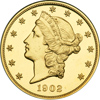 |
1902 $20 Liberty. NGC graded Proof 66 Cameo. In NGC holder 1741159-030. Untoned and well struck. Only 114 Proofs minted. Of the small number of Double Eagle Proofs minted in this low total mintage year (business strikes are also scarce as hen's teeth), recent approximations put the number of survivors at roughly half of the original Proof total or 55 to 60 pieces. From this esteemed group, many have little or no field-to-device contrast. This eye appealing Cameo Gem specimen, on the other hand, is comprised of deep glassy brilliant fields, with strong enough contrast to have earned the coveted "Cameo" title. Indeed, this is the Finest Certified by the service! Spectacular quality for a special set of Proof gold coins. Pop 1; none finer at NGC (PCGS # 89118) .
Estimated Value $90,000 - 100,000.
View details and enlarged photos
Check results on similar lots
| Realized
$97,750 |
Lot 1299 |
 |
1902 $20 Liberty. NGC graded Proof 65. NGC serial number 4477280-008. A gem all brilliant Proof example and warm golden-orange in color. Only 114 proofs struck. The display of warm golden toning ingratiates itself over both sides. Exceedingly choice for the grade, 1902 also happens to be a rare date as a Proof with few of the pieces struck 106 years ago in this outstanding Gem condition. Of the original number perhaps 30 or 40 still remain locked away in collections, high grade examples being especially rare (just run your vision over the supplied population figures at the end of this text). We are under the certain presumption that 1902 deserves exclusive mention, due in part to the scarcity of existing business strike population figures, but chiefly from the paucity of certified samples from the main the grading services.
This is an attractive piece that shows some light field-to-device contrast but not enough to give it a cameo dimension. The deep, watery mirrored fields display a plethora of visible mint sparkle and dancing light when the coin is tilted at various angles, a common occurrence for the few remaining high grade Liberty double eagles. All things considered, a very attractive example of a very elusive year. Pop 2; 1 finer in PF-66 at NGC. PCGS has graded 1 example at this level (PCGS # 9118) .
How to explain the so-called "orange peel" surface on America's Proof gold coins? After the dies are hubbed and the date is applied, the die is given multiple polishes with progressively finer and finer polish. The last polish given to the dies prior to being hardened gives the field a surface quite like a mirror. This is the deepest mirror attainable on the dies. When the die is hardened, the metal shrinks slightly creating a wavy effect on the polished surfaces. It looks somewhat like the surface of an orange. When you see orange peel on a Proof issue like this 1902 $20 you can be sure that it is one of the first examples struck from those dies. Later polishing to the already hardened dies will produce a flatter and shallower mirror.
Estimated Value $75,000 - 85,000.
View details and enlarged photos
Check results on similar lots
| Unsold |
Lot 1300 |
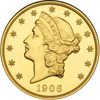 |
1906 $20 Liberty. NGC graded Proof 66 Cameo. In NGC holder 1858221-001. Fully brilliant and untoned. Only 94 Proofs struck. A unforgettable Gem Proof with sleek, brilliant yellow-gold surfaces and beautifully mirrored fields. An ocean of mint sparkle covers each side lending a fully original appearance. The strike is typically razor-sharp (including the stars forming an arc around Liberty), and we can point to full detail behind Liberty's ear and the central reverse devices as being exceptionally complete. (Some Liberty $20 Proofs are weak in these areas.) No obvious distractions to prevent this example from attaining possibly an even finer grade designation, other than perhaps a small mark on the cheek below the lovelock curl.
With low production that rarely exceeded 100 Proofs in any one year, Proof Type 3 Liberty Double Eagles are of the maximum desirability. The impaired state of many, tied to the scarcity of corresponding business strikes in 1906, obviously enhances the attraction of this spectacular Proof 66! From an original mintage of 94, the coin presented here is one of the few genuine "cameo" Proofs available to collectors. Pop 2; none finer at NGC (PCGS # 9122) .
Diagnostic: This 1906, due to extensive polishing of the die during preparation, has the bridge of Liberty's nose weakened at the eye, a common occurrence on numerous gold Proofs, not only the double eagles.
Estimated Value $90,000 - 100,000.
View details and enlarged photos
Check results on similar lots
| Realized
$92,000 |
Lot 1301 |
 |
1906 $20 Liberty. NGC graded Proof 65 Cameo. Brilliant yellow gold, untoned with delicately frosted devices. A splendid gem example, free from spots and noticable imperfections. Only 94 proofs minted.
One of the most attractive and memorable Proofs of this year with sleek mirror surfaces, deep and watery offset by lovely cameo frost. The light taste of patina over each side lends a further note of beauty. The strike is razor-sharp, including the hair waves above and below Liberty's ear plus the key central reverse design which sometimes comes off marginally incomplete on the Proofs issued in 1900-07. Superlative throughout as achieved from attaining the highest possible attraction for its grade. With low mintage that rarely exceeds 100 pieces, Proof Type 3 Liberty double eagles enjoy the maximum value and desirability. There are only a handful of "cameo" Proof 1906 twenties recorded by the grading services. (On most examples, the 1906 issue had strong details before polishing removed the bridge of Liberty's nose, a common occurrence seen on the last Proofs to be struck, not only in the double eagles but other gold denominations as well.) Pop 5 with 2 better by a single point. PCGS has graded only 1 example at this level. (PCGS # 89122) .
This lovely Proof $20 was struck at the third Philadelphia Mint, built on Spring Garden St. and opened in 1901. A massive structure nearly a full city block, it was an instant landmark. Characterized by a Roman temple facade, visitors were to marvel at seven themed glass mosaics designed by Louis C. Tiffany in a gold backed vaulted ceiling. The mosaics depicted ancient Roman coin making methods. This ex mint still stands intact with much of the interior as well, serving as the home of the Community College of Philadelphia. (The fourth and current Philadelphia Mint opened its doors in 1969.).
Estimated Value $75,000 - 85,000.
View details and enlarged photos
Check results on similar lots
| Unsold |
Lot 1302 |
 |
1907 $20 St. Gaudens. High relief, wire rim. NGC graded Proof 67. Star. A superb flawless pale golden gem with satiny smooth surfaces which are slightly reflective. Charles Barber was the Mint Engraver when the U.S. government, at the behest of Theodore Roosevelt, contracted with Augustus Saint-Gaudens to prepare designs for the proposed new $20 gold coin. It was Barber who supervised Proof MCMVII High Relief double eagle production. Some Proofs were later sold out of Barber's estate. The Mint undoubtedly struck other pieces for presentation purposes, probably at several different times throughout the final two months of 1907. (Saint-Gaudens had died in August 1907.)
According to sources, unlike the circulation strike High Relief double eagles minted with the Roman Numerals date, which received three impressions from the dies (some say up to five), apparently the Proofs were struck seven times by dies inserted into the Mint's hydraulic medal press in order to bring the features up to full detail. Many of the diagnostics of this beautiful issue in Proof are never found on the pieces meant for circulation.
The present Proof reveals random die polish lines (as prepared) in the fields. The grade confirms it as one of the finest Proof High Relief double eagles certified, and it is solidly within the top examples known for the issue. Both sides exhibit gorgeous surfaces and color, bold devices, no marks of any kind, and aesthetic appeal that leaves all others back in the dust. Both the obverse and the reverse are silent on the subject of bothersome spots or discolored toning, a fact that one expects for the grade. Every element, every intricate feature of the design, is crisply made, and the overall strike is for all intents and purposes full. This is truly a superb representative of Saint-Gaudens' High Relief $20 in Proof condition and is identified by the NGC serial number on the holder: 191009-001. Pop 4; 4 finer.
Historic note: In the summer of 1907, Augustus Saint-Gaudens, who had been in failing health for some time, took a turn for the worse, and in August he died. Ironically, he never lived to see examples of his own double eagle design. After President Roosevelt had been appeased by the striking of 11,250 High Relief coins and an unknown number of Proofs of the same Type, the Mint obtained permission to revise its design, wherein the relief was lowered drastically, the Roman numerals purged from the obverse, and more familiar numeral punches used in their place. This was amenable to high-speed production and from then to the end of the series in 1933 Double Eagles were so made.
Today, the MCMVII issues of 1907 are highly cherished by collectors and are among the favorites in all American numismatics. Proofs are the crème de la crème of the year. It came as no surprise, then when the Treasury Department proposed issuing new gold bullion coins in 1986, no finer design could be devised than to recreate Augustus Saint-Gaudens' 80-year-old masterpiece. The mint even incorporated the Roman numerals.
Estimated Value $140,000 - 160,000.
View details and enlarged photos
| Unsold |
Lot 1303 |
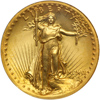 |
1907 $20 St. Gaudens. High relief, wire rim. NGC graded MS-67. Star. A stunning superb gem example exhibiting beaming golden yellow surfaces deepening at the extreme borders. A spectacular star-rated gem whose razor-sharp devices rise like a phoenix bird from the pure-as-gold satiny surface. The fields and devices glow with an almost surreal golden radiance due to the pristine nature of the surface; there are neither handling marks nor spotting of any kind to impair coin's originality. If you as an advanced or specialist collector have been hankering for a first class example of America's most beautiful gold coin, one whose immense presence and technical excellence would be almost impossible to improve on, you will want to ready a bid for this Mint State 67 High Relief. Superb!
As was true of the 1907 Indian designs for the $10 gold Eagle, the present Saint-Gaudens-inspired masterpiece was the end product of President Theodore Roosevelt's orchestration with the most famous American sculptor at the time. As originally envisioned, the mint would redo the entire spectrum of American coinage from the lowly bronze one-cent piece through the noble golden double eagle. In correspondence, Saint-Gaudens felt the 1857 Flying Eagle cent was the finest motif found on any American coin, which is probably the reason he chose a similar eagle for his High Relief $20 gold reverse. Pop 1; 2 finer.
Estimated Value $125,000 - 150,000.
View details and enlarged photos
| Unsold |
Lot 1304 |
 |
1907 $20 St. Gaudens. High relief, wire rim. NGC graded Proof 66. In NGC holder 1938714-001. Frosty and well struck. A dramatic specimen of the Roman Numerals [MCMVII] $20, this piece has been classified as a Proof 66 by NGC. Opinion is still up in the air as to whether Proofs were actually made. PCGS does not acknowledge them, nor did Bowers in his A Guide Book of Double Eagle Gold Coins. Yet, Walter Breen in the Complete Encyclopedia of U.S. and Colonial Proof Coins not only recognized them, but gave rules for identifying them. Proof attributions appear to be from more modern times, since no citations have been found in numismatic catalogues before the 1970s. Neither Roger W. Burdette nor Q. David Bowers, both of whom have studied the subject intensely, can apparently find any archival record.
With this as background, the Gem Proof 66 offered is a desirable, superlative as well as attractive coin, a treat to the eye. Something perhaps worth adding to the smooth finish is how desirable this coin is with its precision strike at Liberty's gown and bodily features, throughout the eagle's plumage, and not limited to that but including the long trailing "flight feathers." Putting it together into a brief review, this specimen has some of the best details we have seen on any Roman Numerals High Relief double eagle in many years. Examine it closely, develop your own estimation as to value, and bid accordingly. It certainly is a resplendent gem! Pop 10; 11 finer, 9 in 67, 1 in 68, 1 in 69.
Estimated Value $70,000 - 80,000.
View details and enlarged photos
| Realized
$71,875 |
Lot 1305 |
 |
1907 $20 St. Gaudens. High relief, wire rim. PCGS graded MS-66. Lovely rich golden toning. Boldly struck. The firm resolve of President Theodore Roosevelt took precedence over Chief Engraver Charles Barber's objection and made the difficult-to-strike High Relief Saint-Gaudens double eagle a reality for a few months in late-1907. Production of what many believe to be the most beautiful regular issue coin in U.S. history commenced November 18, 1907. The mintage is 11,250 coins. This issue was released into circulation, but many were saved for obvious reasons: their artistic beauty. A premium MS66 Gem, the coin is among the most magnificent available with keen, knife-sharp striking detail and satiny surfaces that are free of handling marks. A coin this nice would fit into a high quality date or type set. Pop 63; 20 finer, 16 in 67, 3 in 68, 1 in 69 (PCGS # 9135) .
Estimated Value $70,000 - 75,000.
View details and enlarged photos
Check results on similar lots
| Realized
$75,000 |
Lot 1306 |
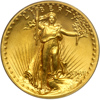 |
1907 $20 St. Gaudens. High relief, wire rim. PCGS graded MS-66. Well struck and lovely golden toning. A fabulous Gem quality representative of the Roman Numerals High Relief double eagle, and the most imaginative 20th Century U.S. gold design. When meeting the qualifications for the MS66 grade, a coin of this caliber must not only offer the awe-struck viewer grand eye appeal from a beautifully executed design, but must provide solid technical features, as well, from the carefully preserved surfaces. The present example is nothing short of exceptional. It is newsworthy. It is a joy to behold. In addition to the aforementioned virtues, both sides display positive, high intensity, warm-gold color. A very tiny pixie standing on everyone's shoulder is whispering into the bidder's ear: bid on me, I am the one. Pop 63; 20 finer, 16 in 67, 3 in 68, 1 in 69 (PCGS # 9135) .
Estimated Value $70,000 - 75,000.
View details and enlarged photos
Check results on similar lots
| Realized
$71,875 |
Lot 1307 |
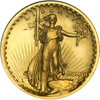 |
1907 $20 St. Gaudens. High relief, wire rim. NGC graded Proof 65. In NGC holder 1919875-007. A nice bold strike. One of the most magnificent coins ever struck, this regal gem boasts creamy rich gold luster throughout and near-perfection surfaces. The strike is razor-sharp on all motifs.
These were coined on the largest press then available, the Mint's medal press using hydraulic pistons to drive the dies, with maximum pressure to bring up the "high" relief cut deeply into the hardened die steel. Not just one strike, but many were essential to fully complete the minute details on Liberty's head, hand and the tops of the eagle's wing features. As seen here, the coin's devices jump right off the surfaces, or so it seems.
Examining the towering rendition of Lady Liberty is like observing Switzerland's Matterhorn when compared to normally struck, post high-relief coins of this denomination. Collectors needn't be reminded that the High Reliefs were basically experimental pieces, and required surmounting several challenges to remain true to Saint-Gaudens stylistic design. Success was complete, as viewed here, but at a price. Only a few Proofs were made before the high relief devices were greatly reduced to a more high-speed-production friendly lower relief coin.
While we haven't seen all of the other Proof 65s graded by NGC in this illustrious condition, we may assume that they are equally magnificent specimens. Certain to be the centerpiece of any collection and worthy of a strong bid. Pop 16; 21 finer.
Estimated Value $60,000 - 65,000.
View details and enlarged photos
| Unsold |
Lot 1308 |
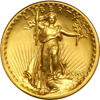 |
1907 $20 St. Gaudens. High relief, flat rim. NGC graded MS-67. Star. A flawless brilliant golden gem! No coin sale would be complete without at least a few offerings of this beautiful and prized High Relief Saint-Gaudens $20 gold piece struck in 1907. The coin is an example of the so-called Flat Rim variety, in which there is no metal forced up between the dies and the restraining collar during repeated impressions, leaving the rim outside the stars even and flat. (Often 3 -- and possibly as many as 5 -- blows by the dies were required to strike this design fully. The surviving numbers of the High Relief twenties has always been a subject of discussion, but those in better grade were obviously set aside at the time of issue and remain cherished possessions today.) A rare high quality coin for the date, this Star example displays enthralling luster whose satin surface is untoned, with sharp detail including Liberty's facial expression, the toes of her advancing foot, and all feather detail. Truly, one in a million and a coin whose aesthetic appeal surpasses them all! Pop 3; 3 finer at NGC.
Historic note: "High Reliefs were struck in 3 blows of the dies on a medal press in the Philadelphia Mint," according to Stack's, in reference to a unique plain edge 1907 High Relief $20 gold piece the firm sold in January 2006. "The first two strikings were made utilizing a plain collar, presumably to prevent the raised edge lettering from being disfigured from successive strikings. It was only during the third striking that the plain collar was replaced by the lettered collar to produce a ''complete'' High Relief Double Eagle with Lettered Edge. Due to the work-hardening of metal that results from the pressures of the striking process, the as yet ''incomplete'' coin was removed from the press after the first and second strikings to be annealed, or softened by heating."
Estimated Value $125,000 - 150,000.
View details and enlarged photos
| Realized
$143,750 |
Lot 1309 |
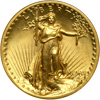 |
1907 $20 St. Gaudens. High relief, flat rim. NGC graded MS-66. Well struck and untoned. An exquisitely beautiful example of this prized MCMVII coin, a satiny gem with radiant yellow surfaces plus a nuance of pale reddish iridescence. Crisply detailed and appealing, a coin that shows Saint-Gaudens mastery of design to its finest extent.
The Roman Numerals pieces have been treasured for decades by collectors for their artistic theme as well as the prestige that owing one offers. Fortunately, enough Gems were saved to afford today's well-placed buyers a steady run of specimens of the date in this grade (although most range from the occasional Very Fine and Extremely Fine coin upward into average Mint State grades). When a gorgeous gem such as the present specimen go under the auctioneer's hammer, the level of participation tends to be intense, since many collectors desire the finest pieces for their collections. The present gem is among the most beautiful MS66 examples seen by PCGS or we miss our guess. Need we say more? Pop 52; 15 finer, 10 in 67, 2 in 67 star, 2 in 68, 1 in 68 star (PCGS # 9136) .
Estimated Value $70,000 - 75,000.
View details and enlarged photos
Check results on similar lots
| Unsold |
Lot 1310 |
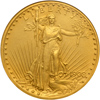 |
1908 $20 St. Gaudens. No motto. NGC graded Matte Proof 66. In NGC holder 1951010-002. Those who have yet to make an acquaintance with a Matte Proof double eagle should know that this is truly an impressive example of the Type. As referred to below in our background narrative, 1908 is the first year made available to collectors with the matte finish in this large $20 format. There are no surface flaws we can detect and only faint hairline or two in the fields: everywhere else the surface is pristine, indeed virtually "as made" and therefore superb. Thus, the Proof 66 grade of this coin which stands head and shoulders above the few others seen.
The mint struck 101 Proofs of this high denomination gold coin in 1908. All were issued with the IN GOD WE TRUST motto, a result of Congressional response to criticism of the action taken by President Roosevelt who eliminated the motto from the newly designed Saint-Gaudens gold pieces in 1907. Roosevelt was a devoutly religious man. He objected to seeing the name of the deity on coinage, and had the courage to impose his convictions on the mint (and thereby on the American public). In 1908, there were two sandblast or matte finishes used, a lighter one of which only 3 are known and the darker finish of the type offered here. This piece very closely resembles the lower denomination Proofs of 1908 which have a coarse-grain finish. Even though the surfaces are deeper in hue than seen on later issues, there is a considerable sparkle of the sandblast finish that is visible when viewed with a loupe.
The 1908 Proof is the first year of the 1908-15 Proof twenties. And though it is true that it is the date most frequently offered among the eight issues in this very rare series, an early writer suggested that an unknown number of Proofs were melted in the mint as unsold on January 2, 1909. Published estimates of the number actually in existence today range from as few as 15 to 25 (Bowers) to as many as 30 to 35 (Akers). We believe the number may have to be expanded to include between 45 and 60 pieces in all grades known today. NGC alone has graded 69 pieces, according to its latest web site enumeration. We can assume many of these are either resubmissions or so-called cross-overs with more than a little duplication in the active number graded. Pop 26; 9 in 67, 2 in 68 (PCGS # 9204) .
Estimated Value $70,000 - 75,000.
View details and enlarged photos
Check results on similar lots
| Realized
$66,125 |
Lot 1311 |
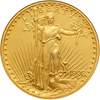 |
1908 $20 St. Gaudens. With motto. NGC graded Proof 66. In NGC holder 1916800-001. Well struck. Only 101 Proofs minted. An impressive example of this first Proof issue struck with the matte or sandblast finish in this large $20 gold format. We see no nicks, spots, or grazes in the delicate surface that could be used by naysayers wishing to humble its pristine beauty. In other words, the coin is pretty much "as struck," placing it near the high end of its grade as well as of this first-year of issue. While it would be a mistake to call the 1908 Proof twenties common, this is the date most routinely offered among the eight Proof dates in the Saint-Gaudens series. We are honored to have been consigned two remarkable Proof 66 examples of this 1908 With Motto Proof. Either piece would make a stunning centerpiece in a collection of rare United States gold coins.
If you have yet to make an acquaintance with a Matte Proof double eagle, this is an impressive example of the Type. Pop 25; 11 finer, 9 in 67, 2 in 68 (PCGS # 9205) .
Estimated Value $70,000 - 75,000.
View details and enlarged photos
Check results on similar lots
| Unsold |
Lot 1312 |
 |
1911 $20 St. Gaudens. NGC graded Matte Proof 68. In NGC holder 1997075-001. Well struck and exceptionally beautiful. Only 100 Proofs minted. All seen to date are of the sandblast type, nearest to 1908 and of nearly the same color. Of the 100 Proofs made, possibly fewer than 30 survive.
First on the docket (to be followed by an almost-as-spectacular Proof 66 1911 example) is this remarkable Proof 68, a superb as any ever offered for sale. How collectors of the day could shun such coins is impossible to comprehend today, when Proof double eagles are considered to be the premiere gold coins of American numismatics. It has been suggested the mint produced on speculation small numbers of Matte (or more properly "Sandblast") Proofs each year. (Read how these were made in the description following the 1911 Proof 66 $20 lot.)
The public expected Brilliant Proofs in those days, similar in appearance to the just expired Liberty head design. However, Mint craftsmen were unable to provide such due to the uneven "basining" required when preparing Saint-Gaudens unusual design. Instead, a matte-surface finish was chosen to offer to collectors. Few buyers ordered them, and even fewer coins survive today out of what were sold since a number of gold Proofs are known to have been spent during the economic downturn in the 1930s. Estimates of survivors for this year may be on the order of 25 to 35 separate pieces. Continual resubmitting to the grading services gives a false population, particularly the Proof 63 to 65 grades.
With the 1911 issue, the mint returned to its heavier sandblast finish that began in 1908. This piece, like others of its kind, shows myriad beautiful tiny sparkles under a loupe, with the color being greenish to perhaps slightly brownish mustard color, and quite alluring. Almost impossible to find in Proof 68 quality! The surfaces are immaculate. The strike, flawless in its precision, with every device showing the finest detail. This is a genuine museum piece for sale to average collectors not just the nobility, a coin that appears free of spotting and without blemish. We can imagine no finer example to acquire for ones rare coin portfolio. Pop 5; none finer at NGC (PCGS # 9208) .
Estimated Value $100,000 - 115,000.
View details and enlarged photos
Check results on similar lots
| Realized
$115,000 |
Lot 1313 |
 |
1911 $20 St. Gaudens. NGC graded Matte Proof 66. As seems plain today but wasn't known until a few years ago, even though the official mintage for Proofs of this year is listed in the archives as 100 pieces, this is really a perplexing number because so few 1911 Proofs are known. The public was never as enthusiastic about Matte Proofs as mint officials were and, as a result, few were ordered and even fewer survive today. Estimates of survivors for this date range up to 35 separate pieces today in all grades.
Technically, this is a sandblast piece, but a Gem "Matte" Proof nevertheless, with strong fundamental supporting surfaces free of marks, devoid of spots, tops in its class, and for that matter, mesmerizing to gaze upon. Nicely struck, though not that it matters our saying so since all 1911 Proofs twenties were made with the utmost care under a strict quality control regime.
Proofs were struck at the Philadelphia Mint on the mint's hydraulic medal press to insure even flow into the die recesses, and a bold relief. America's sandblast Proofs (often referred to as "Matte" finish in numismatic circles) resulted from some experimentation in 1907 at the mint after it was discovered the earlier mirror-finish with frosted relief ensemble was impossible to achieve on Saint-Gaudens' new design. Owing to the peculiarity of the design of the Saint-Gaudens coins, the entire planchet is struck in such a way that the whole surface of the coin loses the brilliant, polished finish so much valued by collectors. The net result is that the coins left the dies with a bright or satiny appearance. The officials at the Mint decided that since they could not make brilliant Proofs, and wanted something distinctive for collectors, they would sandblast the finished coins.
With the 1911 issue, the mint returned to the heavy sandblast appearance of 1908. This piece shows thousands of tiny sparkling facets under magnification and the basic mustard color is overlaid by a thin veneer of olive-green. The surfaces are flawless. This is a true museum-quality piece that appears totally without blemish. We could find no trace of contact on either side, there are no shiny spots, we could not even find a lamination in the planchet. Pop 15; 4 in 67, 5 in 68 (PCGS # 9208) .
Estimated Value $70,000 - 75,000.
View details and enlarged photos
Check results on similar lots
| Realized
$74,750 |
Lot 1314 |
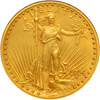 |
1914 $20 St. Gaudens. NGC graded Proof 66. In NGC holder 1951009-003. Only 70 Proofs struck. With so few Proof double eagles minted in 1914, and possibly even fewer distributed to collectors (this being the end of the era for matte Proof coinage), is it any wonder collectors yearn to own a gorgeous 1914 Proof? Survival estimates range from a low of 10 to 15 pieces on up to 20 to 25 coins (the latter being Akers's estimate).
Breen describes the 1914 Proofs as having a "coarse sandblast finish." Similar to 1911 and 1912, this piece has slightly larger granularity to the finish than does a comparable Proof 1913. Millions of tiny, diamond-sparkle facets comprise the sandblast finish, and so give it a unique sparkle which is almost mesmerizing when viewed under low-power magnification. There are no surface flaws that we can discover and the sharp detail compares favorably with the crispness seen on the finest examples of this Type. Considering this, as well as the irrefutable eye appeal of the coin, the Proof 66 grade places this in an illustrious group of high-end specimens. An extraordinary chance for the advanced numismatist to acquire a rare date Matte Proof twenty in tip-top condition. Pop 9; 5 finer, 4 in 67, 1 in 68 (PCGS # 9211) .
Estimated Value $70,000 - 80,000.
View details and enlarged photos
Check results on similar lots
| Unsold |
Lot 1315 |
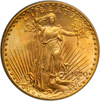 |
1920-S $20 St. Gaudens. PCGS graded MS-64. A wonderful full strike including full facial features on Liberty. The lustrous surfaces exhibit delicate mint bloom colors. A brilliant coin with dazzling luster, so unusual for this extremely rare S-mint date, virtually three-dimensional, almost jumping out at the viewer. Talk about a '20-S with a lot of life! Beyond that, the striking is needle sharp, everything comes together to yield an opportunity that should be quite electrifying.
A solidly graded example is also something to talk about, since this specimen displays only the barest minimum "identifying" marks. We can list them in an instant since there are so few: a series of small scuffs to the left and right of the torch end, including a minor nick on the torch itself; a further tiny scuff line in Liberty's gown folds about in line with her kneecap; on the eagle's wings, a few light marks including one shallow horizontal depression on the trailing flight feathers above the thigh of the leg. Best of all, the rims are quite choice. They are free of the usual sad indignities like marks or edge bumps. To reiterate, the strike is complete, the luster swimming, with nothing, repeat, nothing, keeping this coin out of its stated Mint State 64 grade. Pop 11; 3 in 65, 2 in 66 (PCGS # 9171) .
The history of this 1920-S issue is sad but interesting. As is the case with other $20 gold pieces struck during the Roaring 'Twenties and early 'Thirties, mainly these were stored in bank vaults as backing for checking account deposits and Gold Certificates, the principal "hard money" back then. People have forgotten that under a gold standard (which ended in 1933), paper money and checking deposits weren't money at all but were commonly termed "money substitutes" or "promised money" payable on demand in the monetary metal. They were described as such in the college textbooks.
All went fairly well but with emerging distress in the system when, at the depths of the Great Depression in 1933, a banking panic caused the Roosevelt administration to withdraw gold from circulation. The amount withdrawn is estimated at $2.8 billion (or approximately. $130 billion at today's gold price).
Whatever coins resided in the banks and at the various sub-Treasury buildings around the country were transferred to the government's account. In their place, the was issued Series of 1929 Federal Reserve Bank Notes. Numismatists may remember these from their brown seal and serial numbers. These had the backing of The Full Faith and Credit of the Government instead of hard assets.
(Most 1920-S twenties that weren't exported from this group now owned by the government were melted beginning in 1937, to be turned into heavy 400-oz. "Coin-Gold" .900 Fine bars that are today stored in such depositories as Fort Knox. Gold ownership was re-legalized in January 1975, through an act of congress.).
Estimated Value $150,000 - 165,000.
View details and enlarged photos
Check results on similar lots
| Unsold |
Lot 1316 |
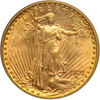 |
1921 $20 St. Gaudens. PCGS graded MS-62. A frosty mint example with light golden-orange toning. Light chatter marks are noted on both sides, none of which are noteworthy. A naturally toned Brilliant Uncirculated example and well within the narrow margins of the "Choice" category. Gleaming effervescent luster with its wisp toning boosts the visual attractiveness of the coin with its residual cartwheel frost. A few scattered marks as noted are to be found on the obverse, including a small one at the thigh and another in the field to the left of the torch end, while the reverse boasts a much fresher appearance that is almost bereft of marks.
Broadly speaking, there are three classes of double eagles: common dates (of which hundreds of thousands are known), scarce dates (with a few hundred to a couple of thousand available, but not always seen in every auction), and then we have the truly rare dates. 1921 exemplifies the latter class. A decidedly low mintage of 528,500 pieces was produced in the depths of the short, deep post-World War I business depression. Like other twenties in those days, most of the 1921 issue was kept in storage in U.S. Treasury vaults and presumably melted after 1933, with only a few score reaching actual circulation. Fewer still were preserved in Mint State grades. David Akers' research established that more than half of all extant specimens are in circulated grades, while most of the others grade no higher than Mint State 60. This coin's appreciably better status places it at High Rarity-7 in Akers' rarity scale.
In terms of total pieces known, the 1921 is fourth rarest in the Saint-Gaudens double eagle series after the 1907 Ultra High Relief, 1927-D, and 1933. Although there may be more 1921 double eagles in numismatic collections, the date is more difficult to find in Mint condition than even the widely admired 1930-S and 1931-D. That makes this attractive Mint State 62 an offering of considerable importance to 21st century gold specialists. Be forewarned: Bidders may be surprised to feel a shrewd kick in their estimates arising from the other savvy competitors in the room hoping to snag it when this piece crosses the auction block. Pop 23; 9 in 63, 3 in 64, 3 in 65, 1 in 66 (PCGS # 9172) .
Estimated Value $170,000 - 190,000.
View details and enlarged photos
Check results on similar lots
| Unsold |
Lot 1317 |
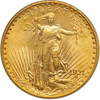 |
1921 $20 St. Gaudens. PCGS graded MS-61. In PCGS holder 21871633. A popular key date. Lightly toned and frosty. Identifiable by a few marks through both of Liberty's legs above and below the knees depending on which leg you are looking at. Without this we suppose the grade would be two points higher since the surface condition is decidedly choice, the luster glows. A worldly measure of pouring satin-frosted luster livens up the wide expanse of detail on this key date 1921. The fields are for all intents and purposes naturally toned, while the strike is intrepid enough to call for special mention on what is sometimes a poorly made year. Only 528,500 pieces minted. Most were melted. Pop 6; 39 finer, 23 in 62, 9 in 63, 3 in 64, 3 in 65, 1 in 66 (PCGS # 9172) .
Estimated Value $120,000 - 130,000.
View details and enlarged photos
Check results on similar lots
| Unsold |
|
|